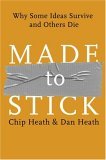My posts about “Made to Stick” and visual controls created some interesting responses on Jon Miller’s Gemba Panta Rei blog, so I want to continue the great dialog. Jon asks the great question “Is your lean deployment made to stick?” and extends the context from just visual controls to the entire concept.
Of course this level of thinking is the author’s intent in the book. I’d like to ask you, the reader and change agent, some questions that might help you see if you are obscuring your own message.
What is core message of your implementation?
The words “vision” and “mission” are so worn out today that people are cynical. And with good reason. By the time the board rooms are done with wordsmithing, there is no content left.
When I was growing up, current events in the USA were dominated by two stories:
- The war in Vietnam.
- Sending people to the moon.
Both were major undertakings and consumed a lot of talent and resources. Consider the core message for each.
Vietnam: Bad things will happen if we leave.
The Moon: “…achieving the goal, before this decade is out, of landing a man on the Moon, and returning him safely to the Earth.”
Which is those is “sticky?” Which one captures the essence of True North so that everyone just knows not only what we are trying to do, but how they can contribute?
Take JFK’s commitment and put it in the language of a typical corporate mission statement: “We will be a world leader in space exploration.” Yawn. How will we know when we get there? Exactly. It is a very safe goal since it allows redefining success at any point.
Kennedy’s commitment is simple, concrete, credible, emotionally appealing, and made a hell of a story. How does yours stand up?
But we so-called “lean professionals” are by no means off the hook.
What is the core message of the TPS?
That is a little tougher to get to. Why? My theory is that we “professionals” are all cursed with what Heath and Heath call “the curse of knowledge.” We understand the nuances and details of how all of the pieces fit together. The question is: How much of that wealth of knowledge passes the “So What?” test. What is the lead story?
When you start talking about takt time, work sequences, cycle times, kanban loops, andon signals, painting lines on the floor, all of the so-called “tools” of the TPS, do people’s eyes glaze over? What ties it all together? What is the central theme, the core message?
I’ve re-written this paragraph about a dozen times. How can we get it down to Herb Kelleher’s “Southwest is the low-fare airline” (p 29 in the book) and not lose anything?
I think, at its fundamental core, the Toyota Production System is “A structured work environment which captures people’s creativity and focuses it solving problems every day.”
The next line in the story: “All of the tools, techniques, principles that people associate with the Toyota Production System are simply the best currently known mechanisms to surface problems, or they are the best currently known countermeasures to common problems.”
Nope, that is still to complicated.
The Toyota Production System structures the organization and the work so that people can solve problems to save time.
That comes closer. I think a test question: “Does that save time?” (without compromising safety, quality or the customer in any way) would usually discriminate between a good idea and a bad one.
Readers – there is no way on Earth (or the moon) that I have got this right, or even close, sitting here in a Beijing apartment at 11pm on a muggy Saturday night. My challenge is: in one sentence, as direct as “The low-fare airline,” capture the core message of the TPS in a way that guides decisions toward True North.
Next – your training.
Most of us use some kind of training materials. Question: Does each topic have a lead? Does it build the story? Does it tie to the top story? As you go into more depth, are the interconnections more and more apparent? Do you tie everything back to the TPS Lead Story? Failure to do these things decomposes the system. It gives people the impression they can pick and choose the tools vs. understanding that they all are doing the same thing in different contexts. It implies there is some kind of set-piece sequence of implementation.
Are your examples concrete? Are they things people can go do?
Do you build a shared experience base by telling stories? Or do you deliver abstract, cold, analytical bullet lists of “the three elements of standard work?” Who cares? Obviously they are important, but how well do you communicate exactly why balance to the takt time contributes to the effort of surfacing and solving problems?
OK – it is late, and I am rambling. I hope I have provoked a little thought.
I originally titled this piece “Is Your Lean Implementation Velcro or Teflon?” But Velcro Industries has enough challenges protecting their trademark without me making it worse.

